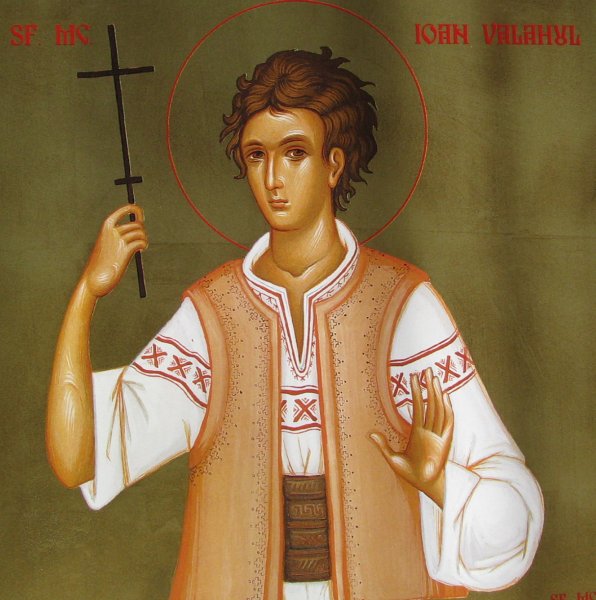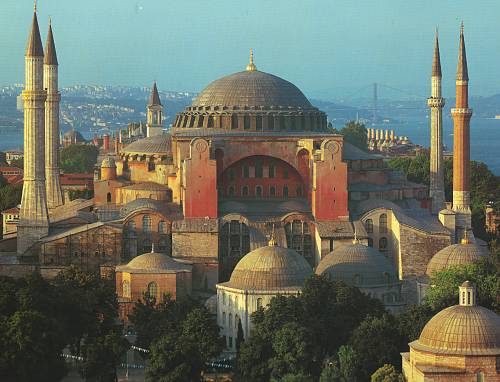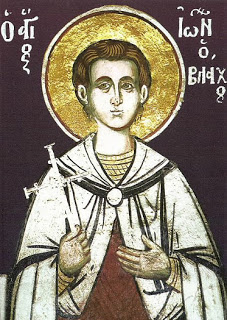 Saint John the Wallachian is a martyr of the medieval times. He was from Wallachia, or the „Romanian Country”, that is today the southern part of Romania and died in Istanbul, because he refused to convert to Islam, on 12 May 1662.
Saint John the Wallachian is a martyr of the medieval times. He was from Wallachia, or the „Romanian Country”, that is today the southern part of Romania and died in Istanbul, because he refused to convert to Islam, on 12 May 1662.
St. John was born probably a few years before the middle of the 17th century in a village near the river Jiu, in the southeastern part of the today Romania, during the reign of the Voivod of Wallachia Matei Basarab (1632-1654), the most prolific builder of churches (46 and many restorations works) in the whole Romanian history. After the death of him it followed his nephew Constantin Şerban (1654-1658) and Mihnea III Radu (1658-1659). The latter took the power with the help of the Turks. Wallachia was a tributary principality to the Ottoman Empire for about 200 years already and many voivods used to gain the throne by offering big sums of money to the sultan. Mihnea probably took his throne through the same method, but shortly after he didn’t want to accept the big taxes imposed to the country by the Turks. So he made an alliance with the prince of Transylvania George Rakoczy II and the voivod of Moldova Constantin Şerban (the former ruler in Wallachia) against the Ottomans. Shortly after, in 1658 he ordered the killing of the squadron of 2000 Turk soldiers, attacked and destroyed some ports and bridges at the Danube. His attack was coordinated with similar rebellions in Moldova and Transylvania. In the spring of 1659 the Turks invaded Moldova ant Transylvania. Mihnea reported some small victories against the invaders but finally fled in Transylvania where he died poisoned on 6 April. On their way back, the Turks crossed Wallachia on the valley of Jiu and took a lot of prisoners. Among them was John, a 15 years young boy of „good ancestry” as his biographer, John Kariophiles noted, that meaning from a noble family.
 All the prisoners were, according to the Ottoman law, the slaves of the sultan, being bought back by their real possessors, usually the soldiers, for a sum of money. The soldier who captured John was attracted by his handsomeness and tried to seduce him. After some resistance, the soldier told him to accept the orders from his master, but John replied that his only master is Jesus Christ. Then he tried to tie the young on a tree in order to rape him. But the boy escaped in a moment, killed that soldier and tried to flee. He was caught and taken to Constantinople, where the soldiers led him to the Grand Vizier (a kind of prime minister in the Ottoman state), who decided to give him to the wife of the killed, so that she will decide what to do with him. The widow decided to keep him because of his handsome look. The next two years and a half he remained as a slave in her house and she tried to seduce him, but he resisted, even if she promised that she will take him as husband and give him a good status, if he will accept to convert to Islam. He refused her offer and the woman decided him finally to send him to the prison and trial him for the murder he committed. In the prison he was praying incessantly to Christ, in order to strengthen him to keep his faith during the tortures. Even here the widow came daily in order to persuade him but he did not accept to renounce to the faith of his ancestors.
All the prisoners were, according to the Ottoman law, the slaves of the sultan, being bought back by their real possessors, usually the soldiers, for a sum of money. The soldier who captured John was attracted by his handsomeness and tried to seduce him. After some resistance, the soldier told him to accept the orders from his master, but John replied that his only master is Jesus Christ. Then he tried to tie the young on a tree in order to rape him. But the boy escaped in a moment, killed that soldier and tried to flee. He was caught and taken to Constantinople, where the soldiers led him to the Grand Vizier (a kind of prime minister in the Ottoman state), who decided to give him to the wife of the killed, so that she will decide what to do with him. The widow decided to keep him because of his handsome look. The next two years and a half he remained as a slave in her house and she tried to seduce him, but he resisted, even if she promised that she will take him as husband and give him a good status, if he will accept to convert to Islam. He refused her offer and the woman decided him finally to send him to the prison and trial him for the murder he committed. In the prison he was praying incessantly to Christ, in order to strengthen him to keep his faith during the tortures. Even here the widow came daily in order to persuade him but he did not accept to renounce to the faith of his ancestors.
Finally he was taken out of the prison and brought to a place called Parmak-Kapi („the gate of the finger”, or “of the pillar”), near Bezesteni, the great bazaar of the merchants, in the Galata quarter of Istanbul. There he was hanged on 12 May 1662, being younger than 18. It might be that his body was thrown in the Bosporus waters, as it was the use, or maybe he was buried by the Christians, but this information remains unknown.
His life was written by a scholar of the Ecumenical Patriachate, named John Kariophiles and printed in Venice in 1799 by the hagiograph Nikodimos Hagiorites, the same one who compiled the Orthodox theological book called „Philokalia”, and translated in 1801 in Romanian together with the life of St. Dimitrie Basarabov. The vita of the saint was introduced into the Greek Menologion from 1843 in the day of his death, 12 May. The same happened three years later, in 1846 in the Romanian Menologies.
In spite of being Romanian, St. John remained as an „anonymous” among the more important saints celebrated on 12 May, Epiphanius of Salamis and Patriarch Germanos of Constantinople. Only in 1950, during a meeting of the Romanian Synod it was decided the generalization of his cult, that meaning it was proceeded to the composition of his own liturgical service, and five years later (1955) he was officially proclaimed among the other national saints.

